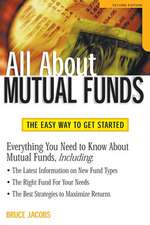Equity Management: The Art and Science of Modern Quantitative Investing, Second Edition
Autor Bruce Jacobs, Kenneth Levyen Limba Engleză Hardback – 16 noi 2016
From Bruce Jacobs and Ken Levy—two pioneers of quantitative equity management— the go-to guide to stock selection has been substantially updated to help you build portfolios in today’s transformed investing landscape.
A powerful combination of in-depth research and expert insights gained from decades of experience, Equity Management, Second Edition includes 24 new peer-reviewed articles that help leveraged long-short investors and leverage-averse investors navigate today’s complex and unpredictable markets.
Retaining all the content that made an instant classic of the first edition—including the authors’ innovative approach to disentangling the many factors that influence stock returns, unifying the investment process, and integrating long and short portfolio positions—this new edition addresses critical issues. Among them--
• What’s the best leverage level for long-short and leveraged long-only portfolios?
• Which behavioral characteristics explain the recent financial meltdown and previous crises?
• What is smart beta—and why should you think twice about using it?
• How do option-pricing theory and arbitrage strategies lead to market instability?
• Why are factor-based strategies on the rise?
Equity Management provides the most comprehensive treatment of the subject to date. More than a mere compilation of articles, this collection provides a carefully structured view of modern quantitative investing. You’ll come away with levels of insight and understanding that will give you an edge in increasingly complex and unpredictable markets.
Well-established as two of today’s most innovative thinkers, Jacobs and Levy take you to the next level of investing. Read Equity Management and design the perfect portfolio for your investing goals.
| Toate formatele și edițiile | Preț | Express |
|---|---|---|
| Paperback (1) | 376.81 lei 23-29 zile | +50.75 lei 4-10 zile |
| McGraw Hill Education – 30 iun 2015 | 376.81 lei 23-29 zile | +50.75 lei 4-10 zile |
| Hardback (1) | 443.19 lei 23-29 zile | |
| McGraw Hill Education – 16 noi 2016 | 443.19 lei 23-29 zile |
Preț: 443.19 lei
Preț vechi: 584.91 lei
-24% Nou
Puncte Express: 665
Preț estimativ în valută:
84.81€ • 92.10$ • 71.24£
84.81€ • 92.10$ • 71.24£
Carte disponibilă
Livrare economică 03-09 aprilie
Preluare comenzi: 021 569.72.76
Specificații
ISBN-13: 9781259835247
ISBN-10: 1259835243
Pagini: 896
Dimensiuni: 163 x 236 x 66 mm
Greutate: 1.2 kg
Ediția:2
Editura: McGraw Hill Education
Colecția McGraw-Hill
Locul publicării:United States
ISBN-10: 1259835243
Pagini: 896
Dimensiuni: 163 x 236 x 66 mm
Greutate: 1.2 kg
Ediția:2
Editura: McGraw Hill Education
Colecția McGraw-Hill
Locul publicării:United States
Cuprins
Foreword to First Edition by Harry M. Markowitz, Nobel Laureate
Foreword to Second Edition by Harry M. Markowitz, Nobel Laureate
Preface
Acknowledgments
INTRODUCTION
Our Approach to Quantitative Investing
PART ONE
Profiting in a Multidimensional, Dynamic World
Chapter 1
Ten Investment Insights that Matter
The Stock Market Is a Complex System
Market Complexity Can be Exploited with a Rich, Multidimensional Model
Return-Predictor Relationships Should Be Disentangled
An Investment Firm Should Abide By the Law of One Alpha
The Investment Process Should Be Dynamic and Transparent
A Customized, Integrated Investment Process Preserves Insights
Integrated Long-Short Optimization Can Provide Enhanced Returns and Risk Control for Market-Neutral and 130-30 Portfolios
Alpha from Security Selection Can Be Transported to Any Asset Class
Portfolio Optimization Should Take into Account an Investor’s Aversion to Leverage
Beware of Risk Shifting, Free Lunches, and Irrational Markets
Conclusion
Chapter 2
The Complexity of the Stock Market
The Evolution of Investment Practice
Web of Return Regularities
Disentangling and Purifying Returns
Advantages of Disentangling
Evidence of Inefficiency
Value Modeling in an Inefficient Market
Risk Modeling versus Return Modeling
Pure Return Effects
Anomalous Pockets of Inefficiency
Empirical Return Regularities
Modeling Empirical Return Regularities
Bayesian Random Walk Forecasting
Conclusion
Chapter 3
Disentangling Equity Return Regularities: New Insights and Investment Opportunities
Previous Research
Return Regularities We Consider
Methodology
The Results on Return Regularities
P/E and Size Effects
Yield, Neglect, Price, and Risk
Trends and Reversals
Some Implications
January versus Rest-of-Year Returns
Autocorrelation of Return Regularities
Return Regularities and Their Macroeconomic Linkages
Conclusion
Chapter 4
On the Value of ‘Value’
Value and Equity Attributes
Market Psychology, Value, and Equity Attributes
The Importance of Equity Attributes
Examining the DDM
Methodology
Stability of Equity Attributes
Expected Returns
Naïve Expected Returns
Pure Expected Returns
Actual Returns
Power of the DDM
Power of Equity Attributes
Forecasting DDM Returns
Conclusion
Chapter 5
Calendar Anomalies: Abnormal Returns at Calendar Turning Points
The January Effect
Rationales
The Turn-of-the-Month Effect
The Day-of-the-Week Effect
Rationales
The Holiday Effect
The Time-of-Day Effect
Conclusion
Chapter 6
Forecasting the Size Effect
The Size Effect
Size and Transaction Costs
Size and Risk Measurement
Size and Risk Premiums
Size and Other Cross-Sectional Effects
Size and Calendar Effects
Modeling the Size Effect
Simple Extrapolation Techniques
Time-Series Techniques
Transfer Functions
Vector Time-Series Models
Structural Macroeconomic Models
Bayesian Vector Time-Series Models
Chapter 7
Earnings Estimates, Predictor Specification, and Measurement Error
Predictor Specification and Measurement Error
Alternative Specifications of E/P and Earnings Trend for Screening
Alternative Specifications of E/P and Trend for Modeling Returns
Predictor Specification with Missing Values
Predictor Specification and Analyst Coverage
The Return-Predictor Relationship and Analyst Coverage
Summary
PART TWO
Managing Portfolios in a Multidimensional, Dynamic World
Chapter 8
Engineering Portfolios: A Unified Approach
Is the Market Segmented or Unified?
A Unified Model
A Common Evaluation Framework
Portfolio Construction and Evaluation
Engineering ‘Benchmark’ Strategies
Added Flexibility
Economies
Chapter 9
The Law of One Alpha
Chapter 10
Residual Risk: How Much Is Too Much?
Beyond the Curtain
Some Implications
Chapter 11
High-Definition Style Rotation
High-Definition Style
Pure Style Returns
Implications
High-Definition Management
Benefits of High-Definition Style
Chapter 12
Smart Beta versus Smart Alpha
Supported By Theory?
Active or Passive?
Forward-Looking and Dynamic?
Concentrated Risk Exposures?
Unintended Risk Exposures?
Factor Integration and Risk Control?
Turnover Levels?
Liquidity and Overcrowding?
Transparent or Proprietary?
Conclusion
Chapter 13
Smart Beta: Too Good To Be True?
Smart Beta Portfolios are Passive
Smart Beta Targets the Most Significant Return-Generating Factors
Smart Beta Portfolios are Well Diversified
Smart Beta Factors Perform Consistently
Smart Beta Portfolios Benefit from Mean-Reversion in Prices
Smart Beta Portfolios Can be Efficiently Combined
Smart Beta Benefits from Transparency
Smart Beta has Nearly Unlimited Capacity
Smart Beta Streamlines the Investment Decision Process for Investors
Smart Beta Costs Less than Active Investing
Conclusion
Chapter 14
Is Smart Beta State of the Art?
Chapter 15
Investing in a Multidimensional Market
The Market’s Multidimensionality
Advantages of a Multidimensional Approach
Conclusion
PART THREE
Expanding Opportunities with Market-Neutral Long-Short Portfolios
Chapter 16
Long-Short Equity Investing
Long-Short Equity Strategies
Societal Advantages of Short-Selling
Equilibrium Models, Short-Selling, and Security Prices
Practical Benefits of Long-Short Investing
Portfolio Payoff Patterns
Long-Short Mechanics and Returns
Theoretical Tracking Error
Advantages of the Market-Neutral Strategy over Long Manager plus Short Manager
Advantages of the Equitized Strategy over Traditional Long Equity Management
Implementation of Long-Short Strategies: Quantitative versus Judgmental
Implementation of Long-Short Strategies: Portfolio Construction Alternatives
Practical Issues and Concerns
Shorting Issues
Trading Issues
Custody Issues
Legal Issues
Morality Issues
What Asset Class Is Long-Short?
Conclusion
Chapter 17
20 Myths About Long-Short
Chapter 18
The Long and Short on Long-Short
Building a Market-Neutral Portfolio
A Question of Efficiency
Benefits of Long-Short
Equitizing Long-Short
Trading Long-Short
Evaluating Long-Short
Chapter 19
Long-Short Portfolio Management: An Integrated Approach
Long-Short: Benefits and Costs
The Real Benefits of Long-Short
Costs: Perception versus Reality
The Optimal Portfolio
Neutral Portfolios
Optimal Equitization
Conclusion
Chapter 20
Alpha Transport with Derivatives
Asset Allocation or Security Selection
Asset Allocation and Security Selection
Transporter Malfunctions
Matter-Antimatter Warp Drive
To Boldly Go
PART FOUR
Expanding Opportunities with Enhanced Active 130-30 Portfolios
Chapter 21
Enhanced Active Equity Strategies: Relaxing the Long-Only Constraint in the Pursuit of Active Return
Approaches to Equity Management
Enhanced Active Equity Portfolios
Performance: An Illustration
The Enhanced Prime Brokerage Structure
Operational Considerations
Comparison to Other Long-Short Strategies
Conclusion
Appendix: Weighted-Average Capitalization Weights
Chapter 22
20 Myths About Enhanced Active 120-20 Strategies
Chapter 23
Enhanced Active Equity Portfolios Are Trim Equitized Long-Short Portfolios
Market-Neutral, Equitized, and Enhanced Active Portfolios
Trimming an Equitized Portfolio
Enhanced Active versus Equitized Portfolios
Benchmark Index Choices
Conclusion
Chapter 24
On the Optimality of Long-Short Strategies
Portfolio Construction and Problem Formulation
Optimal Long-Short Portfolios
Optimality of Dollar Neutrality
Optimality of Beta Neutrality
Optimal Long-Short Portfolio with Minimum Residual Risk
Optimal Long-Short Portfolio with Specified Residual Risk
Optimal Equitized Long-Short Portfolio
Optimality of Dollar Neutrality with Equitization
Optimality of Beta Neutrality with Equitization
Optimal Equitized Long-Short Portfolio with Specified Residual Risk
Optimal Equitized Long-Short Portfolio with Constrained Beta
Conclusion
PART FIVE
Optimizing Portfolios with Short Positions
Chapter 25
Trimability and Fast Optimization of Long-Short Portfolios
General Mean-Variance Problem
Long-Short Constraints in Practice
Diagonalized Models of Covariance
Factor Models
Scenario Models
Historical Covariance Models
Modeling Long-Short Portfolios
Applying Fast Techniques to the Long-Short Model
Trimability
Consequences of Trimability
Example
Summary
Chapter 26
Portfolio Optimization with Factors, Scenarios, and Realistic Short Positions
The General Mean-Variance Problem
Solution to the General Problem
Diagonalizable Models of Covariance
Factor Models
Scenario Models
Historical Covariance Matrices
Short Sales in Practice
Modeling Short Sales
Solution to Long-Short Model
Example
Summary
PART SIX
Optimizing Portfolios for Leverage-Averse Investors
Chapter 27
Leverage Aversion and Portfolio Optimality
Optimal Enhancement with Leverage Aversion
An Example with Leverage Aversion
Conclusion
Chapter 28
Leverage Aversion, Efficient Frontiers, and the Efficient Region
Specifying the Leverage-Aversion Term
Specification of the Leverage-Aversion Term Using Portfolio Total Volatility
Optimal Portfolios with Leverage-Aversion Based on Portfolio Total Volatility
Efficient Frontiers With and Without Leverage Aversion
Efficient Frontiers for Various Leverage-Tolerance Cases
The Efficient Region
Conclusion
Appendix: Comparison of the Enhancement Surfaces Using Two Different Specifications
Chapter 29
Introducing Leverage Aversion into Portfolio Theory and Practice
Chapter 30
A Comparison of the Mean-Variance-Leverage Optimization Model and the Markowitz General Mean-Variance Portfolio Selection Model
Leverage Risk—A Third Dimension
Quartic versus Quadratic Optimization
Practical Insights from the MVL Optimization Model
Conclusion
Chapter 31
Traditional Optimization is Not Optimal for Leverage-Averse Investors
Mean-Variance Optimization with a Leverage Constraint
The Leverage-Averse Investor’s Utility of Optimal Mean-Variance Portfolios
Mean-Variance-Leverage Optimization versus Leverage-Constrained Mean-Variance Optimization
Conclusion
Chapter 32
The Unique Risks of Portfolio Leverage: Why Modern Portfolio Theory Fails and How to Fix It
The Limitations of Mean-Variance Optimization
Mean-Variance Optimization with Leverage Constraints
Mean-Variance-Leverage Optimization
Optimal Mean-Variance-Leverage Portfolios and Efficient Frontiers
The Mean-Variance-Leverage Efficient Region
The Mean-Variance-Leverage Efficient Surface
Optimal Mean-Variance-Leverage Portfolios versus Optimal Mean-Variance Portfolios
Volatility and Leverage in Real-Life Situations
Conclusion
PART SEVEN
Shifting Risk Can Lead to Financial Crises
Chapter 33
Option Pricing Theory and its Unintended Consequences
Chapter 34
When Seemingly Infallible Arbitrage Strategies Fail
Chapter 35
Momentum Trading: The New Alchemy
Chapter 36
Risk Avoidance and Market Fragility
Insuring Specific versus Systematic Risk
Insurance and Systemic Risk
Risk Sharing versus Risk Shifting
Chapter 37
Tumbling Tower of Babel: Subprime Securitization and the Credit Crisis
Risk-Shifting Building Blocks
RMBSs
ABCP, SIVs, and CDOs
CDSs
What Goes Up…
The Rise of Subprime
Low Risk for Sellers and Buyers
High Risk for the System
…Must Come Down
Positive Feedback’s Negative Consequences
Fault Lines
Conclusion: Building From the Ruins
PART EIGHT
Simulating Security Markets
Chapter 38
Financial Market Simulation
Types of Dynamic Models
JLM Simulator
Status
Events
Initialization
Reoptimization
Order Review
End of Day
Objectives and Extensions
Alternative Investor and Trader Behaviors
Model Size
Advantages of Asynchronous Finance Models
Caveat
Conclusion
Chapter 39
Simulating Security Markets in Dynamic and Equilibrium Modes
Simulation Overview
Dynamic Analysis
Different Initial Random Seeds
Different Ratios of Momentum to Value Investors
Trading and Anchoring Rules
Trading rules
Anchoring rules
Capital Market Equilibrium
Expected Return Estimation Method
Case Study
Conclusion
Index
Foreword to Second Edition by Harry M. Markowitz, Nobel Laureate
Preface
Acknowledgments
INTRODUCTION
Our Approach to Quantitative Investing
PART ONE
Profiting in a Multidimensional, Dynamic World
Chapter 1
Ten Investment Insights that Matter
The Stock Market Is a Complex System
Market Complexity Can be Exploited with a Rich, Multidimensional Model
Return-Predictor Relationships Should Be Disentangled
An Investment Firm Should Abide By the Law of One Alpha
The Investment Process Should Be Dynamic and Transparent
A Customized, Integrated Investment Process Preserves Insights
Integrated Long-Short Optimization Can Provide Enhanced Returns and Risk Control for Market-Neutral and 130-30 Portfolios
Alpha from Security Selection Can Be Transported to Any Asset Class
Portfolio Optimization Should Take into Account an Investor’s Aversion to Leverage
Beware of Risk Shifting, Free Lunches, and Irrational Markets
Conclusion
Chapter 2
The Complexity of the Stock Market
The Evolution of Investment Practice
Web of Return Regularities
Disentangling and Purifying Returns
Advantages of Disentangling
Evidence of Inefficiency
Value Modeling in an Inefficient Market
Risk Modeling versus Return Modeling
Pure Return Effects
Anomalous Pockets of Inefficiency
Empirical Return Regularities
Modeling Empirical Return Regularities
Bayesian Random Walk Forecasting
Conclusion
Chapter 3
Disentangling Equity Return Regularities: New Insights and Investment Opportunities
Previous Research
Return Regularities We Consider
Methodology
The Results on Return Regularities
P/E and Size Effects
Yield, Neglect, Price, and Risk
Trends and Reversals
Some Implications
January versus Rest-of-Year Returns
Autocorrelation of Return Regularities
Return Regularities and Their Macroeconomic Linkages
Conclusion
Chapter 4
On the Value of ‘Value’
Value and Equity Attributes
Market Psychology, Value, and Equity Attributes
The Importance of Equity Attributes
Examining the DDM
Methodology
Stability of Equity Attributes
Expected Returns
Naïve Expected Returns
Pure Expected Returns
Actual Returns
Power of the DDM
Power of Equity Attributes
Forecasting DDM Returns
Conclusion
Chapter 5
Calendar Anomalies: Abnormal Returns at Calendar Turning Points
The January Effect
Rationales
The Turn-of-the-Month Effect
The Day-of-the-Week Effect
Rationales
The Holiday Effect
The Time-of-Day Effect
Conclusion
Chapter 6
Forecasting the Size Effect
The Size Effect
Size and Transaction Costs
Size and Risk Measurement
Size and Risk Premiums
Size and Other Cross-Sectional Effects
Size and Calendar Effects
Modeling the Size Effect
Simple Extrapolation Techniques
Time-Series Techniques
Transfer Functions
Vector Time-Series Models
Structural Macroeconomic Models
Bayesian Vector Time-Series Models
Chapter 7
Earnings Estimates, Predictor Specification, and Measurement Error
Predictor Specification and Measurement Error
Alternative Specifications of E/P and Earnings Trend for Screening
Alternative Specifications of E/P and Trend for Modeling Returns
Predictor Specification with Missing Values
Predictor Specification and Analyst Coverage
The Return-Predictor Relationship and Analyst Coverage
Summary
PART TWO
Managing Portfolios in a Multidimensional, Dynamic World
Chapter 8
Engineering Portfolios: A Unified Approach
Is the Market Segmented or Unified?
A Unified Model
A Common Evaluation Framework
Portfolio Construction and Evaluation
Engineering ‘Benchmark’ Strategies
Added Flexibility
Economies
Chapter 9
The Law of One Alpha
Chapter 10
Residual Risk: How Much Is Too Much?
Beyond the Curtain
Some Implications
Chapter 11
High-Definition Style Rotation
High-Definition Style
Pure Style Returns
Implications
High-Definition Management
Benefits of High-Definition Style
Chapter 12
Smart Beta versus Smart Alpha
Supported By Theory?
Active or Passive?
Forward-Looking and Dynamic?
Concentrated Risk Exposures?
Unintended Risk Exposures?
Factor Integration and Risk Control?
Turnover Levels?
Liquidity and Overcrowding?
Transparent or Proprietary?
Conclusion
Chapter 13
Smart Beta: Too Good To Be True?
Smart Beta Portfolios are Passive
Smart Beta Targets the Most Significant Return-Generating Factors
Smart Beta Portfolios are Well Diversified
Smart Beta Factors Perform Consistently
Smart Beta Portfolios Benefit from Mean-Reversion in Prices
Smart Beta Portfolios Can be Efficiently Combined
Smart Beta Benefits from Transparency
Smart Beta has Nearly Unlimited Capacity
Smart Beta Streamlines the Investment Decision Process for Investors
Smart Beta Costs Less than Active Investing
Conclusion
Chapter 14
Is Smart Beta State of the Art?
Chapter 15
Investing in a Multidimensional Market
The Market’s Multidimensionality
Advantages of a Multidimensional Approach
Conclusion
PART THREE
Expanding Opportunities with Market-Neutral Long-Short Portfolios
Chapter 16
Long-Short Equity Investing
Long-Short Equity Strategies
Societal Advantages of Short-Selling
Equilibrium Models, Short-Selling, and Security Prices
Practical Benefits of Long-Short Investing
Portfolio Payoff Patterns
Long-Short Mechanics and Returns
Theoretical Tracking Error
Advantages of the Market-Neutral Strategy over Long Manager plus Short Manager
Advantages of the Equitized Strategy over Traditional Long Equity Management
Implementation of Long-Short Strategies: Quantitative versus Judgmental
Implementation of Long-Short Strategies: Portfolio Construction Alternatives
Practical Issues and Concerns
Shorting Issues
Trading Issues
Custody Issues
Legal Issues
Morality Issues
What Asset Class Is Long-Short?
Conclusion
Chapter 17
20 Myths About Long-Short
Chapter 18
The Long and Short on Long-Short
Building a Market-Neutral Portfolio
A Question of Efficiency
Benefits of Long-Short
Equitizing Long-Short
Trading Long-Short
Evaluating Long-Short
Chapter 19
Long-Short Portfolio Management: An Integrated Approach
Long-Short: Benefits and Costs
The Real Benefits of Long-Short
Costs: Perception versus Reality
The Optimal Portfolio
Neutral Portfolios
Optimal Equitization
Conclusion
Chapter 20
Alpha Transport with Derivatives
Asset Allocation or Security Selection
Asset Allocation and Security Selection
Transporter Malfunctions
Matter-Antimatter Warp Drive
To Boldly Go
PART FOUR
Expanding Opportunities with Enhanced Active 130-30 Portfolios
Chapter 21
Enhanced Active Equity Strategies: Relaxing the Long-Only Constraint in the Pursuit of Active Return
Approaches to Equity Management
Enhanced Active Equity Portfolios
Performance: An Illustration
The Enhanced Prime Brokerage Structure
Operational Considerations
Comparison to Other Long-Short Strategies
Conclusion
Appendix: Weighted-Average Capitalization Weights
Chapter 22
20 Myths About Enhanced Active 120-20 Strategies
Chapter 23
Enhanced Active Equity Portfolios Are Trim Equitized Long-Short Portfolios
Market-Neutral, Equitized, and Enhanced Active Portfolios
Trimming an Equitized Portfolio
Enhanced Active versus Equitized Portfolios
Benchmark Index Choices
Conclusion
Chapter 24
On the Optimality of Long-Short Strategies
Portfolio Construction and Problem Formulation
Optimal Long-Short Portfolios
Optimality of Dollar Neutrality
Optimality of Beta Neutrality
Optimal Long-Short Portfolio with Minimum Residual Risk
Optimal Long-Short Portfolio with Specified Residual Risk
Optimal Equitized Long-Short Portfolio
Optimality of Dollar Neutrality with Equitization
Optimality of Beta Neutrality with Equitization
Optimal Equitized Long-Short Portfolio with Specified Residual Risk
Optimal Equitized Long-Short Portfolio with Constrained Beta
Conclusion
PART FIVE
Optimizing Portfolios with Short Positions
Chapter 25
Trimability and Fast Optimization of Long-Short Portfolios
General Mean-Variance Problem
Long-Short Constraints in Practice
Diagonalized Models of Covariance
Factor Models
Scenario Models
Historical Covariance Models
Modeling Long-Short Portfolios
Applying Fast Techniques to the Long-Short Model
Trimability
Consequences of Trimability
Example
Summary
Chapter 26
Portfolio Optimization with Factors, Scenarios, and Realistic Short Positions
The General Mean-Variance Problem
Solution to the General Problem
Diagonalizable Models of Covariance
Factor Models
Scenario Models
Historical Covariance Matrices
Short Sales in Practice
Modeling Short Sales
Solution to Long-Short Model
Example
Summary
PART SIX
Optimizing Portfolios for Leverage-Averse Investors
Chapter 27
Leverage Aversion and Portfolio Optimality
Optimal Enhancement with Leverage Aversion
An Example with Leverage Aversion
Conclusion
Chapter 28
Leverage Aversion, Efficient Frontiers, and the Efficient Region
Specifying the Leverage-Aversion Term
Specification of the Leverage-Aversion Term Using Portfolio Total Volatility
Optimal Portfolios with Leverage-Aversion Based on Portfolio Total Volatility
Efficient Frontiers With and Without Leverage Aversion
Efficient Frontiers for Various Leverage-Tolerance Cases
The Efficient Region
Conclusion
Appendix: Comparison of the Enhancement Surfaces Using Two Different Specifications
Chapter 29
Introducing Leverage Aversion into Portfolio Theory and Practice
Chapter 30
A Comparison of the Mean-Variance-Leverage Optimization Model and the Markowitz General Mean-Variance Portfolio Selection Model
Leverage Risk—A Third Dimension
Quartic versus Quadratic Optimization
Practical Insights from the MVL Optimization Model
Conclusion
Chapter 31
Traditional Optimization is Not Optimal for Leverage-Averse Investors
Mean-Variance Optimization with a Leverage Constraint
The Leverage-Averse Investor’s Utility of Optimal Mean-Variance Portfolios
Mean-Variance-Leverage Optimization versus Leverage-Constrained Mean-Variance Optimization
Conclusion
Chapter 32
The Unique Risks of Portfolio Leverage: Why Modern Portfolio Theory Fails and How to Fix It
The Limitations of Mean-Variance Optimization
Mean-Variance Optimization with Leverage Constraints
Mean-Variance-Leverage Optimization
Optimal Mean-Variance-Leverage Portfolios and Efficient Frontiers
The Mean-Variance-Leverage Efficient Region
The Mean-Variance-Leverage Efficient Surface
Optimal Mean-Variance-Leverage Portfolios versus Optimal Mean-Variance Portfolios
Volatility and Leverage in Real-Life Situations
Conclusion
PART SEVEN
Shifting Risk Can Lead to Financial Crises
Chapter 33
Option Pricing Theory and its Unintended Consequences
Chapter 34
When Seemingly Infallible Arbitrage Strategies Fail
Chapter 35
Momentum Trading: The New Alchemy
Chapter 36
Risk Avoidance and Market Fragility
Insuring Specific versus Systematic Risk
Insurance and Systemic Risk
Risk Sharing versus Risk Shifting
Chapter 37
Tumbling Tower of Babel: Subprime Securitization and the Credit Crisis
Risk-Shifting Building Blocks
RMBSs
ABCP, SIVs, and CDOs
CDSs
What Goes Up…
The Rise of Subprime
Low Risk for Sellers and Buyers
High Risk for the System
…Must Come Down
Positive Feedback’s Negative Consequences
Fault Lines
Conclusion: Building From the Ruins
PART EIGHT
Simulating Security Markets
Chapter 38
Financial Market Simulation
Types of Dynamic Models
JLM Simulator
Status
Events
Initialization
Reoptimization
Order Review
End of Day
Objectives and Extensions
Alternative Investor and Trader Behaviors
Model Size
Advantages of Asynchronous Finance Models
Caveat
Conclusion
Chapter 39
Simulating Security Markets in Dynamic and Equilibrium Modes
Simulation Overview
Dynamic Analysis
Different Initial Random Seeds
Different Ratios of Momentum to Value Investors
Trading and Anchoring Rules
Trading rules
Anchoring rules
Capital Market Equilibrium
Expected Return Estimation Method
Case Study
Conclusion
Index



















